 Story by Christopher Hector & Photos by Roslyn Neave
Story by Christopher Hector & Photos by Roslyn Neave
In 2015 there was a line of thought, thankfully now sinking into the mists of ancient history, that dressage is not good for cross country. Not surprisingly, it is not a theory Ingrid Klimke has ever agreed with…
“When you look at modern eventing courses, where we have many technical elements, it is very important that the rider looks to his or her two responsibilities: to have the right speed / tempo, and the right line. The easier, the smoother, the better, the horse comes through and takes my transition – where I really have to slow down after riding very fast, to have a speed of 560/70 is only possible if you ride at 690 on the flat places where you can gallop – then all of a sudden you need showjumping canter or even less, where you have to have the horse so collected, so through, so focused on the fence.
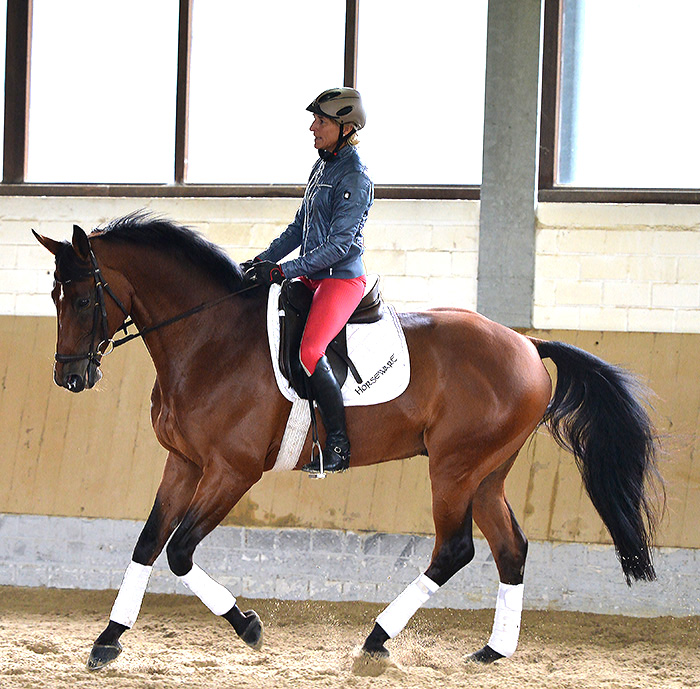
The better my dressage transitions are, the better the thoroughness, it means the horse can go from very fast, to very balanced and collected on the hindquarters, energy from behind, through – no argument with the bit – because the transition is through and fine, the horse can focus on the jump.
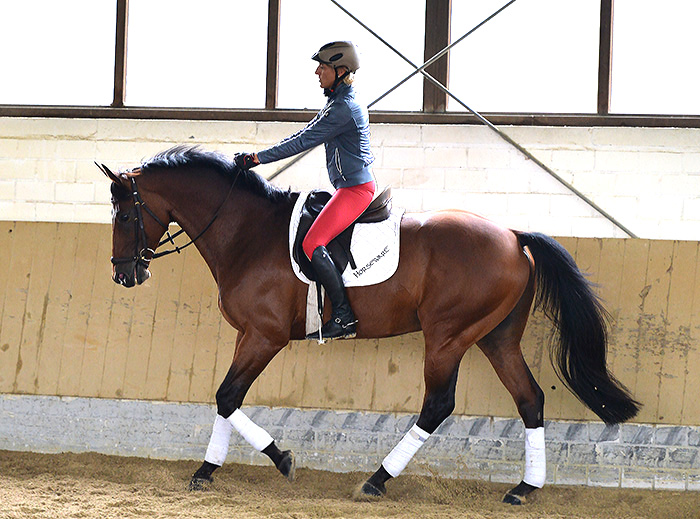
That for me is dressage for cross-country. It is thoroughness, in the transition from fast to slow down, the horse must be on my seat, I sit down, come with my legs, very soft with my hands, and he is through. If you call that dressage, then I am very happy my horse is very good in dressage.”
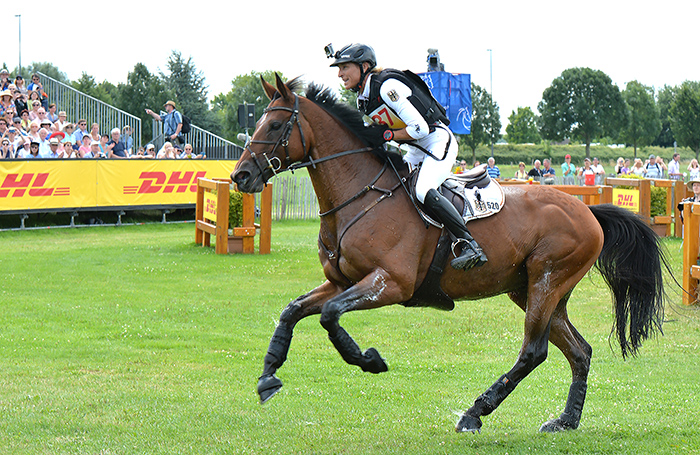
“It is thoroughness, in the transition from fast to slow down, the horse must be on my seat, I sit down, come with my legs, very soft with my hands, and he is through.”
Can you teach an eventer too much dressage?
“No.”
If you thought it would improve Bobby’s (Horseware Hale Bob) trot would you teach him piaffe?
“That’s what I did. Bobby is not a spectacular mover and he had a very poor Thoroughbred trot when I got him at the age of five.
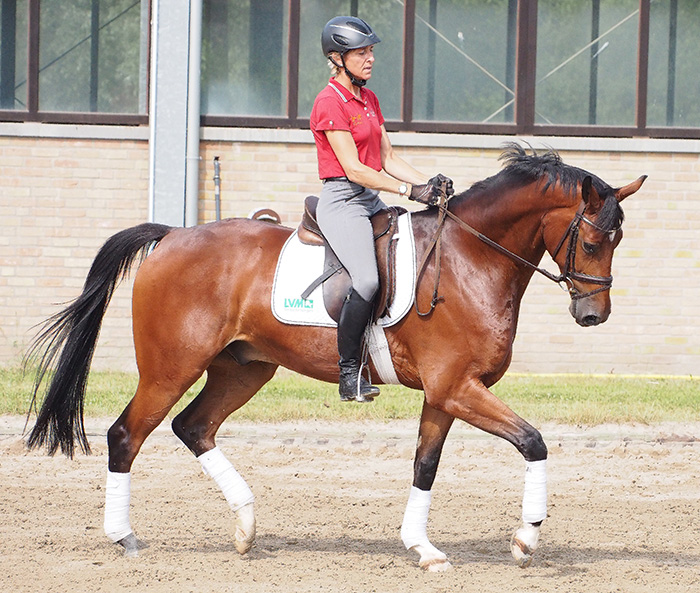
Bobby had a poor Thoroughbred trot at age five

Mr Gehrmann, an in-hand work expert, works with another of Ingrid’s rides at the time, this is sort of work Bobby did to improve his trot by getting is hindlegs together and under his centre of gravity
So for over a year, I did in hand work with him with Mr Gehrmann to try and teach him piaffe, so his hindlegs get more together, not wide any more, under the centre of gravity. He learned some small steps, and without that, he would never be able to do the medium trot he does today, because he would stumble wide, fall on his forehand from the shoulders. No one from the dressage world will ever say that Bobby does piaffe, but he thinks he can.”

Bobby at the ERM in Wiesbaden in 2018
more follows
“With Escada, I taught her proper flying changes, she was so smart and intelligent, she always wanted to do it before I asked her, so I taught her three and four times changes, two time changes, so she knows, the next is coming the next is coming. I taught her two times changes so that the one change can be relaxed and easy.”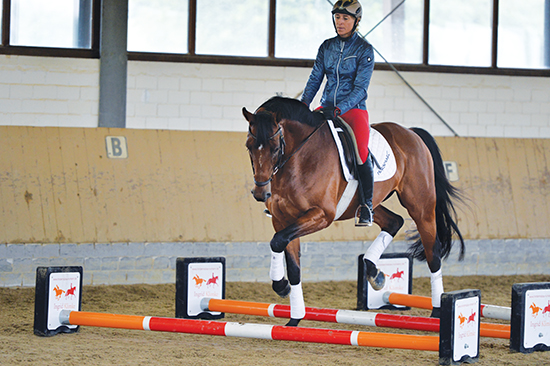
“The other is the pirouette. If the horse sits on his hindlegs and has the energetic, quality collected canter that I need for half pass and pirouettes, it’s good for them. They get stronger behind, they are in better balance and they are much more using their bodies. We are looking for a healthy athlete in the long run, using the exercises I can do in dressage, I can have my horse straight, balanced on both legs, and that means healthy and sound in the long term. This is for me dressage.”
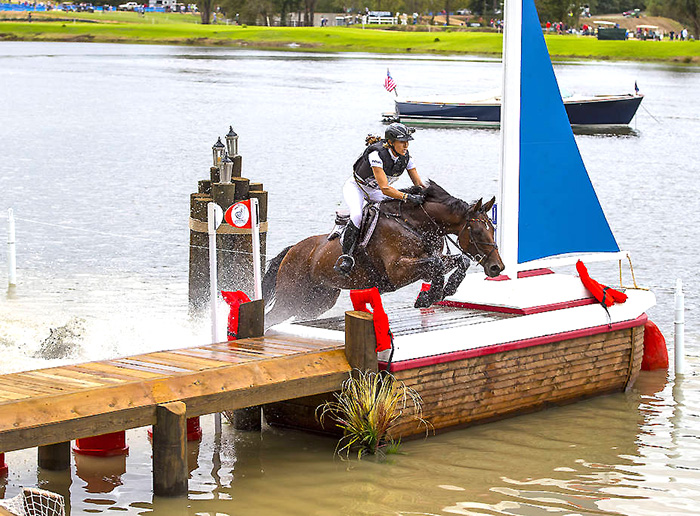
Bobby shows straightness at the WEG in Tryon in 2018
“You have to have straightness on the horse, the straight horse is using all four legs, it is not that the right hind leg fights the spur. The weight of the horse is on all four legs, not on the forehand, or more on one hind leg, so in the long run, with better balance, better dressage, more collection, I have a horse that is more free and balanced.
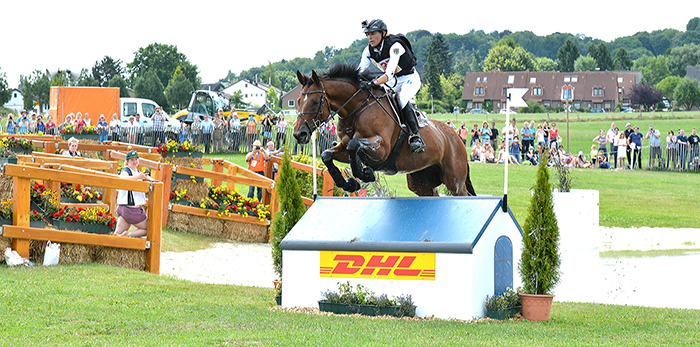
Aachen in 2017
For me quality dressage, not the forced dressage, not where you pull the horse or force the horse to do something, dressage is a dance – you can dance through a test with little aids. The more soft and gentle my aids are on cross country the better, then I can really speed up, slow down, turn – a balanced turn – have my horse absolutely under the centre of gravity. That’s what I need in a pirouette, and that’s what I need in a line like we had at Aachen, where you have a narrow one uphill, down two strides, turn, there the horse must be in balance.”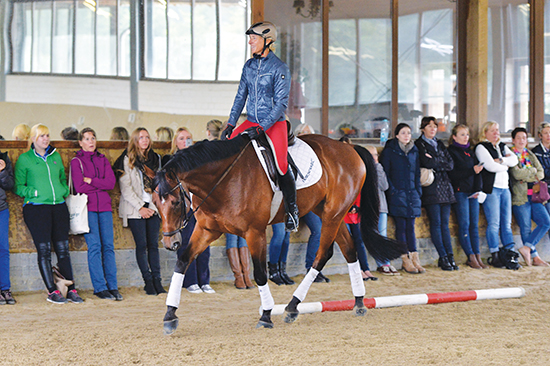
Training dressage doesn’t take the horse’s concentration away from the jump?
“No. The dressage means my influence, my talking to the horse to slow down, to get on his hind legs, sit behind, open up and focus on the jump. This is a proper transition. If my transition is on the forehand, pulling, his nose on the ground, then it is a bad transition – it doesn’t help me for dressage, not for jumping and not for cross-country. You have to do it in the right way. Horses are so smart and intelligent, if your horse is say eleven, and he has done the dressage that they need for the eventing test, then they get totally bored. What do you do for the whole of the winter? Just transitions? Then they start to not like dressage any more. If you give them something interesting, you can do more, you can do changes, you can do pirouettes, half pass / change back – then they like it, because it is new, it is interesting.”
“In the winter I train dressage and jumping to get ready for the next season. If I make this too boring for the horse, just single changes, one half pass, then I don’t know what to do any more. Braxxi is doing wonderful two times changes, at the age of eighteen, he can do a Prix St Georges with my daughter, and as soon as he starts doing some movements, he lights up, oh now we can do something – don’t trot them round and round forever.
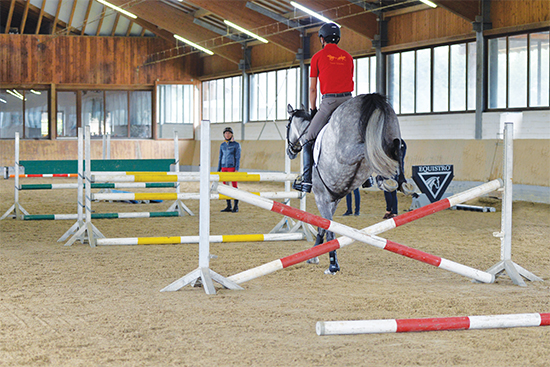 When the horse goes down a gymnastic line of jumps, do you want to leave the horse and alone and let it think it out for itself?
When the horse goes down a gymnastic line of jumps, do you want to leave the horse and alone and let it think it out for itself?
“Leave the horse totally alone. I make sure that I come with the right approach to the first fence, for the rest, I say to the horse, this is totally your job. What I want is fifty – fifty, the same in cross country, my dressage means my transition comes through, and then I say to the horse, now it is your turn, you read the fence, you land properly in the water, you look for the next fence, not me. I guide you, I follow you, I made sure that I close all the doors at the narrow ones and explain to you exactly which way to go, the rest is up to the horse. It must be his responsibility, I don’t want to take it all because it is fifty, fifty.”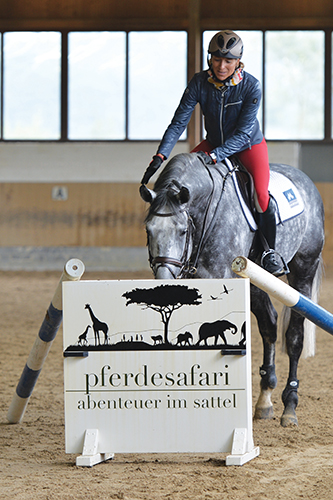
When you set up the lines at home, do you set them at half distances?
“That’s what I did today in the gymnastic, where I didn’t go the straight way where it was easy, because with the more advanced horses, I should just turn and they jump, she should figure out, do I speed up and go, or put in a small one. If I am in trouble, I give my hand and say, it is yours, make something out of it, it is your jump. Chris Bartle always says, cross-country riding is not an exact science. You never know what is going to happen, I want to teach my horse, as soon as he sees a jump, he has to figure it out, he has to read it, and do it.”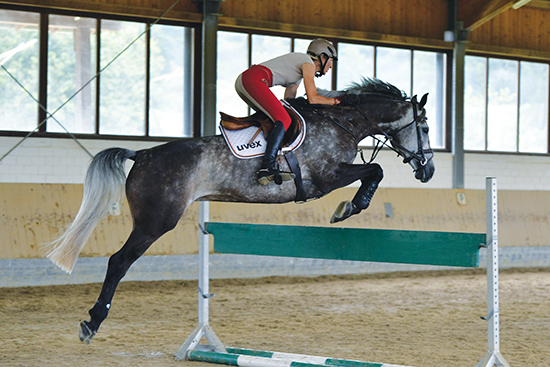
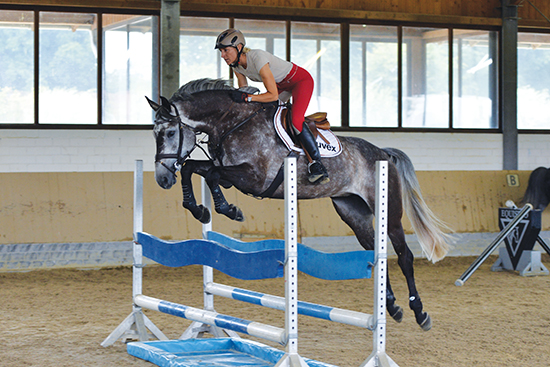 “I didn’t go the straight way where it was easy, because with the more advanced horses, I should just turn and they jump, she should figure out, do I speed up or do I put in a short one?”
“I didn’t go the straight way where it was easy, because with the more advanced horses, I should just turn and they jump, she should figure out, do I speed up or do I put in a short one?”
Thinking back to your ride at the WEG in Caen, it was Escada working out where to go in the water, I don’t think you had much to do with it…
“I was having trouble to stay on, I was seeing the water and me falling into it, she was waiting, and she just jumped out, she was so good. I want this personality.
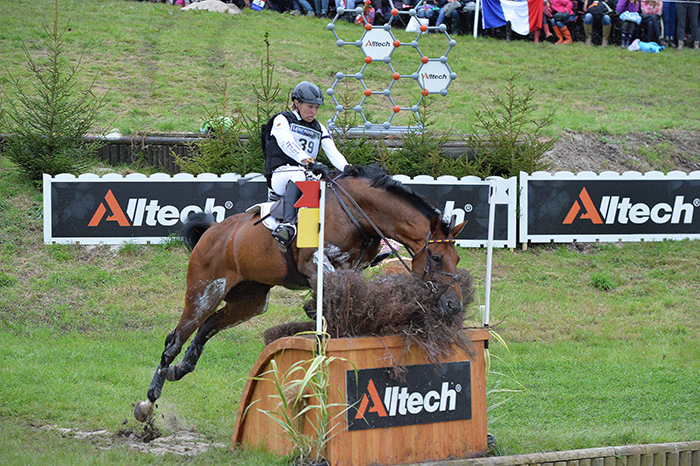
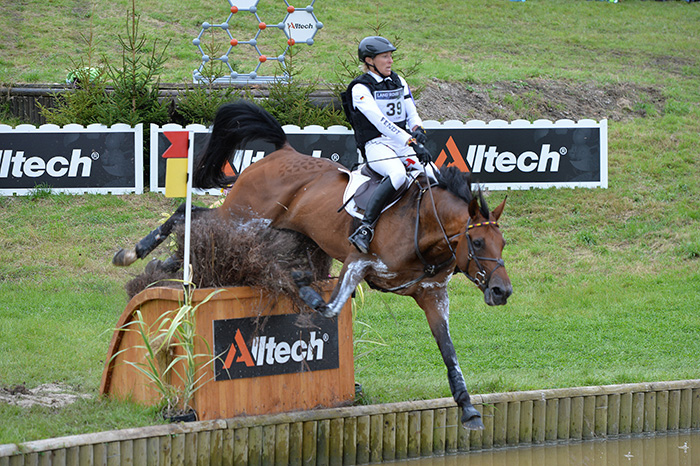
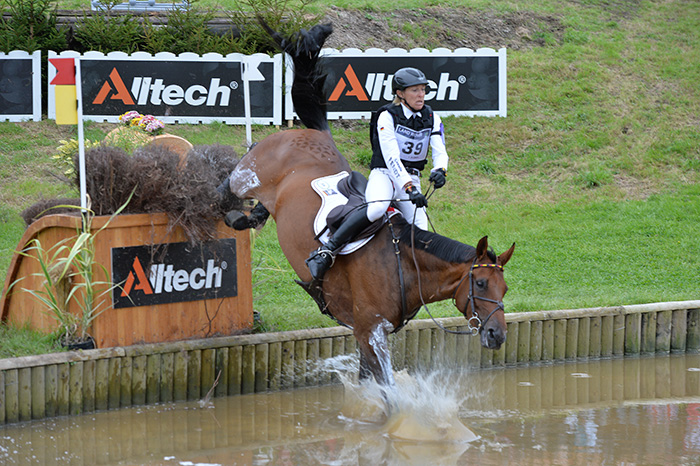
My father always said, it must be between a genius and a little bit crazy – having a dressage horse who is full of himself, having the personality which really wants to do it. It shouldn’t be a horse that is forced to do it, who has given up thinking, I don’t want this in dressage either. I want a horse who knows, oh the piaffe is coming and I am ready for it, I’m waiting for it, when can I do the transition. When can I start my one tempis, they are coming. The horse should think too. That is why the blood horses, the Thoroughbred, the Trakehner, the little bit hotter, more sensitive horse – I choose them for dressage. It is similar for eventing, the Thoroughbred horses are waiting for what is coming, ready for the next adventure, they always have the spirit, I want to do something. Let them do it, and give them the confidence.”
“My job is – here is my transition, here is my line, this is the right speed, and now go for it. Then when you have a really difficult fence, like the one at Aachen, if you see it in a positive way, it was a gymnastic exercise on a circle, you could build it with cavalletti, making two narrows on a circle, two strides, three strides, four strides. If I practice this and it is easy, I can do it in the showjumping or the cross country, this is for me proper dressage.”
For more articles with Ingrid go here:




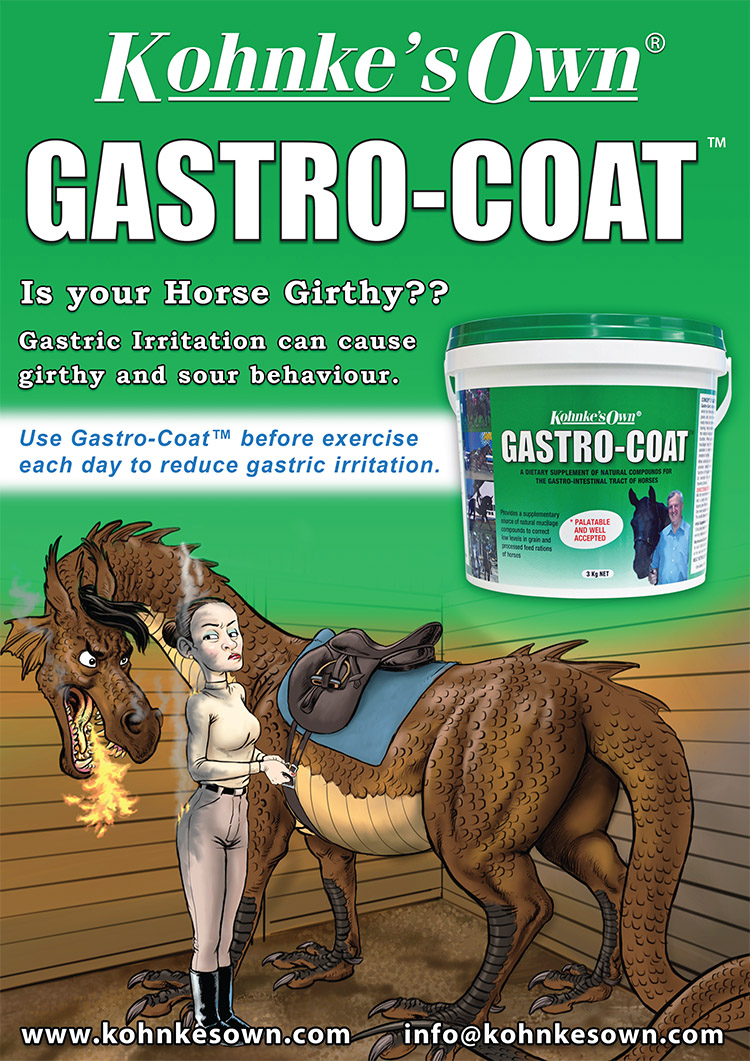
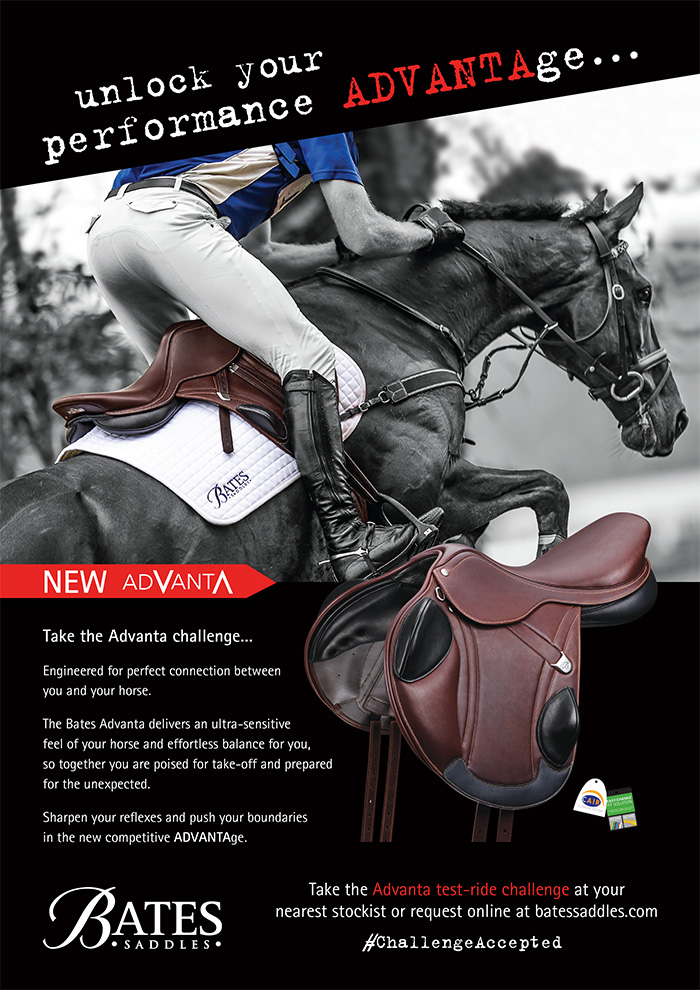
As Colonel Alois Podhajsky proved pre World War II – in a Military event, with one of his dressage horses.
Will more dressage solve the problem of rotational falls at steeplechasing speed?